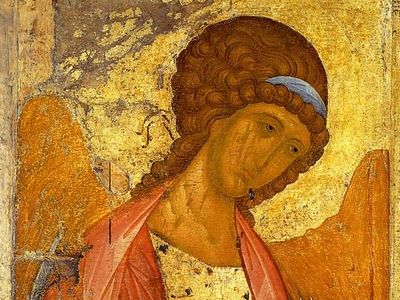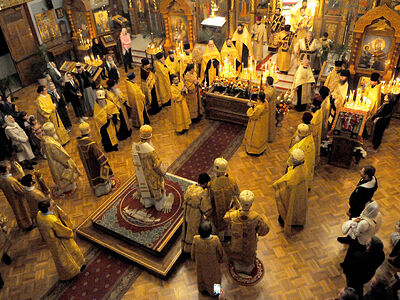
On the  Sunday of the Samaritan Woman
Sunday of the Samaritan Woman
“>fifth Sunday after Pascha, at the Sunday Liturgical reading the Church remembers the Gospel passage, which in theological literature is called, “Christ’s Conversation with the Samaritan Woman” (Jn. 4:5-42).
The theme of the  Sunday of the Paralytic
Sunday of the Paralytic
“>Sunday of the Paralytic continues to develop in it, and completely new notes and meanings begin to sound.
What makes these two Sundays similar? They are united by one common subject.
The time of the Old Testament is over. It was fulfilled in our Lord Jesus Christ. A new era of the New Testament has begun.
The Pool of Bethesda is no longer needed, nor is the descent of the  Feast of St. Archangel MichaelToday, dear brethren, we celebrate the glorious feast of the lightning-like Archangel Michael and all the heavenly bodiless powers. On this day let us talk of the boundless world of the angels.
Feast of St. Archangel MichaelToday, dear brethren, we celebrate the glorious feast of the lightning-like Archangel Michael and all the heavenly bodiless powers. On this day let us talk of the boundless world of the angels.
“>Archangel Michael into it. This is because the One Who is immeasurably greater than the pool and millions of times stronger than the Archangel Michael has come to Bethesda. God, Who deigned to become man for our salvation, has come into the world. He is able to heal all those lying at the Pool of Bethesda with one word, as He did with the paralytic.
During Christ’s meeting with the Samaritan woman, the same thing happens. Though in this case it is not so much the physical as the spiritual healing of a sinful woman—a half-pagan, promiscuous woman. And here, too, there is an Old Testament object—the well of the holy Patriarch Jacob, which provided the whole area with refreshing water in the desert lands of the Southern Levant.
And here is the One Who is greater than water and greater than Patriarch Jacob. He came to give the world new Heavenly bread and new Heavenly water. By the bread that comes down from Heaven (cf. Jn. 6) we should understand the Body and Blood of Christ, and by the new water, the grace-filled gifts of the Holy Spirit, which nourish believers, just as the roots of trees are nourished by living spring water. And the soul of such a person blooms and is fragrant with Heavenly aromas!
And these new Heavenly bread and water become the foundation of the future indestructible Church of the New Testament!
Let us recall the words of the Savior to the Samaritan woman: If thou knewest the gift of God, and Who it is that saith to thee, Give Me to drink; thou wouldest have asked of Him, and He would have given thee living water… Whosoever drinketh of this water shall thirst again: But whosoever drinketh of the water that I shall give him shall never thirst; but the water that I shall give him shall be in him a well of water springing up into everlasting life (Jn. 4:10, 13-14).
And then our Lord Jesus Christ says: But the hour cometh, and now is, when the true worshippers shall worship the Father in spirit and in truth: for the Father seeketh such to worship Him. God is a Spirit: and they that worship Him must worship Him in spirit and in truth (Jn. 4:23, 24).
Here we see a direct relation between water and God the Spirit, Who, together with the Father and the Son, gives this living grace—water—to people.
And he who worships the Father in spirit and in the truth (Jn. 4:23) will drink this living water of God’s grace, and it will give him such bliss and joy that he will never agree to part with it, not for all the riches in the world, even if his biological life is threatened.
This happened, for example, with the Samaritan woman herself (she is known in Church history as the holy Martyr Photina (Svetlana), the Samaritan Woman, and Her SonsDuring the time of the emperor Nero (54-68), who displayed excessive cruelty against Christians, Saint Photina lived in Carthage with her younger son Joses and fearlessly preached the Gospel there.
“>Martyr Photina (in Greek, “light”, “the luminous one”, in Church Slavonic “Svetlana”), with her sons Victor (named Photinus, that is, “Light”) and Joses, and some other martyrs who suffered with the Samaritan woman (Anatola, Phota, Photis, Paraskeva, Kyriake, Domnina and the holy Martyr Sebastian). The feast day of the holy Martyr Photina and those who suffered with her is April 2.
They suffered terrible torments, but did not renounce Christ. Once they had tasted of God’s living water, they became light-bearing and began to radiate light to the world. Because the inner darkness of their heart had been enlightened by the Paschal light of Christ, and they were given real, genuine, blessed life in God. This became their greatest treasure and the pearl of great price, for which one can sacrifice everything (cf. Mt. 13:45, 46).
Today we too have a well, but not Jacob’s. We have a greater one! The Well of the Holy Trinity—the Father, the Son and the Holy Spirit. This is the Church.
The winds of persecution are blowing, trying to destroy and fill this well with sand. But the light-bearing living water of the grace of the Holy Spirit still shines in it. Come and quench your thirst, drink your fill and enjoy it. It will change, purify, heal and sanctify you. And it will give you eternal life.
Christ is Risen! He is Risen Indeed!




 St. Spyridon of Tremithus
St. Spyridon of Tremithus Great Martyr George
Great Martyr George St. Nicholas
St. Nicholas St. Athanasius the Great the Patriarch of AlexandriaSaint Athanasius the Great, Archbishop of Alexandria, was a great Father of the Church and a pillar of Orthodoxy.”>St. Athanasius of Alexandria? What happened earlier—the Dormition of the Most Holy Mother of God or the First Apostolic Council?
St. Athanasius the Great the Patriarch of AlexandriaSaint Athanasius the Great, Archbishop of Alexandria, was a great Father of the Church and a pillar of Orthodoxy.”>St. Athanasius of Alexandria? What happened earlier—the Dormition of the Most Holy Mother of God or the First Apostolic Council? 
 30th anniversary of uncovering of incorrupt relics of St. John (Maximovitch) celebrated in San Francisco (+VIDEOS)One of America’s greatest saints was celebrated in California over the weekend.
30th anniversary of uncovering of incorrupt relics of St. John (Maximovitch) celebrated in San Francisco (+VIDEOS)One of America’s greatest saints was celebrated in California over the weekend. ROCOR to celebrate 30th anniversary of canonization of St. John (Maximovitch) (+VIDEO)The celebration will be held on Friday and Saturday, June 28-29 at the Joy of All Who Sorrow Cathedral in San Francisco, where St. John’s relics are located.”>this summer as well.
ROCOR to celebrate 30th anniversary of canonization of St. John (Maximovitch) (+VIDEO)The celebration will be held on Friday and Saturday, June 28-29 at the Joy of All Who Sorrow Cathedral in San Francisco, where St. John’s relics are located.”>this summer as well. 
 Bulgarian hierarchs concelebrate with Ukrainian schismatics in IstanbulFor the first time, hierarchs of the Bulgarian Orthodox Church concelebrated with representatives of the graceless “Orthodox Church of Ukraine” sect yesterday at Life-giving Spring Monastery in Istanbul.
Bulgarian hierarchs concelebrate with Ukrainian schismatics in IstanbulFor the first time, hierarchs of the Bulgarian Orthodox Church concelebrated with representatives of the graceless “Orthodox Church of Ukraine” sect yesterday at Life-giving Spring Monastery in Istanbul. One Lavra monk joins schismatics to become abbot of their “Lavra”Fr. Avraamy also appealed to the monks of the Lavra who remain faithful to the Church, blaming the present situation on the Holy Synod of the Ukrainian Orthodox Church, which he argues is “inciting hostility and confrontation.”
One Lavra monk joins schismatics to become abbot of their “Lavra”Fr. Avraamy also appealed to the monks of the Lavra who remain faithful to the Church, blaming the present situation on the Holy Synod of the Ukrainian Orthodox Church, which he argues is “inciting hostility and confrontation.” Bulgarian priests and faithful denounce episcopal concelebration with Ukrainian schismaticsIt is noteworthy that the official site of the Bulgarian Orthodox Church never published any news about the concelebration. However, it didn’t escape the attention of the Bulgarian clergy, monastics, and faithful.
Bulgarian priests and faithful denounce episcopal concelebration with Ukrainian schismaticsIt is noteworthy that the official site of the Bulgarian Orthodox Church never published any news about the concelebration. However, it didn’t escape the attention of the Bulgarian clergy, monastics, and faithful. Russian Church rep expelled from Bulgaria, banned from N. Macedonia—Church respondsThe Russian Church’s Department for External Church Relations issued a statement yesterday “strongly protesting against the unjustified expulsion of its representatives from Bulgaria.”
Russian Church rep expelled from Bulgaria, banned from N. Macedonia—Church respondsThe Russian Church’s Department for External Church Relations issued a statement yesterday “strongly protesting against the unjustified expulsion of its representatives from Bulgaria.” Patriarch Neofit appoints Bulgarian priests to church where Russian priests were expelledThe church has served as a representation of the Russian Orthodox Church for many years, but two priests and another church employee were branded threats to national security and expelled from the country last week.
Patriarch Neofit appoints Bulgarian priests to church where Russian priests were expelledThe church has served as a representation of the Russian Orthodox Church for many years, but two priests and another church employee were branded threats to national security and expelled from the country last week. Holy Synod appoints new rector for Russian church in SofiaFr. Vladimir served the Patriarchal Parishes in the USA in various capacities for a decade (1989-1999) and earned a degree from St. Tikhon’s Orthodox Theological Seminary during his time there.”>mid-October, the Russian Holy Synod appointed a new rector.
Holy Synod appoints new rector for Russian church in SofiaFr. Vladimir served the Patriarchal Parishes in the USA in various capacities for a decade (1989-1999) and earned a degree from St. Tikhon’s Orthodox Theological Seminary during his time there.”>mid-October, the Russian Holy Synod appointed a new rector.  Services resume at Russian church in SofiaServices have resumed at the Russian representation Church of St. Nicholas the Wonderworker in Sofia, a month and a half after the former rector was evicted from the country.
Services resume at Russian church in SofiaServices have resumed at the Russian representation Church of St. Nicholas the Wonderworker in Sofia, a month and a half after the former rector was evicted from the country.